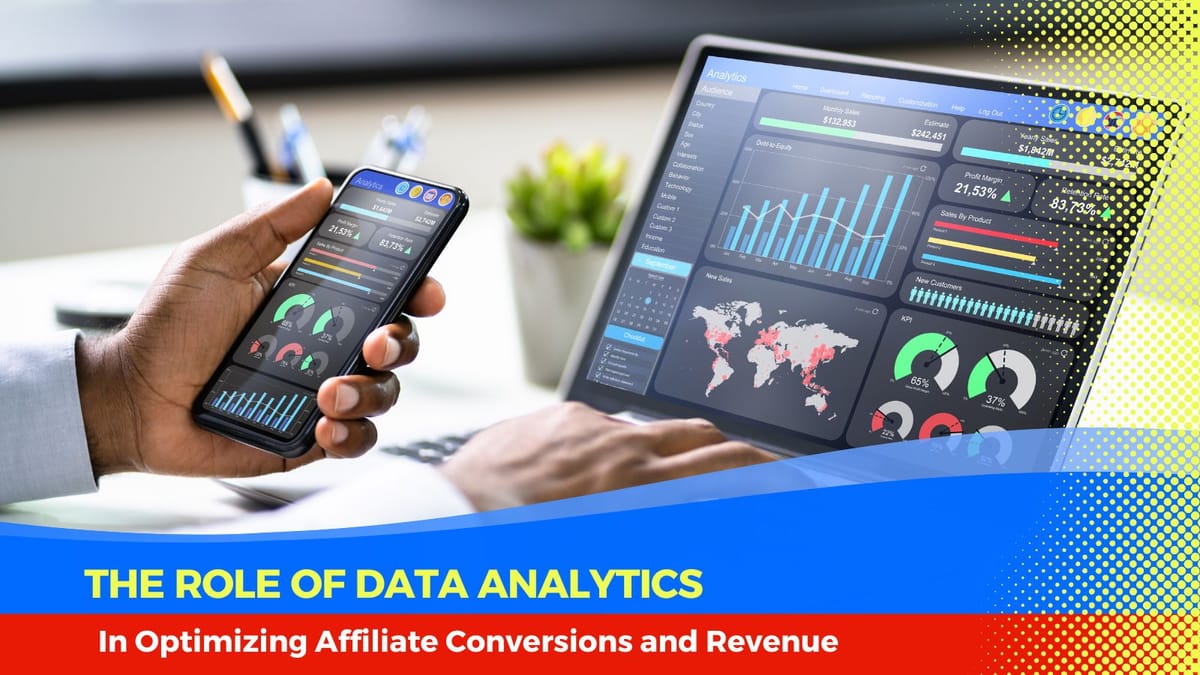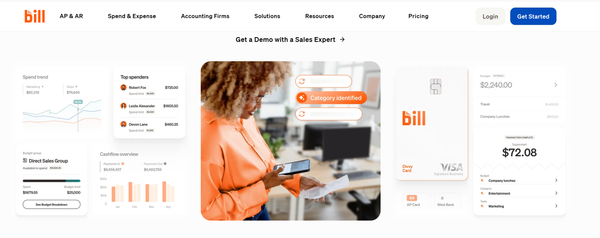The Role of Data Analytics in Optimizing Affiliate Conversions and Revenue
Discover how real-time insights and predictive analytics can transform your marketing strategy and optimize your affiliate conversions and revenue.

You’re striving to boost conversions and increase revenue as an affiliate publisher, influencer, and creator but despite your best efforts, progress feels slow. Data analytics is the game-changer you need. By unlocking insights from the data you already have, you can transform your affiliate marketing strategy.
Discover how data analytics helps you identify high-performing campaigns, understand your audience better, and enhance your affiliate marketing performance. Dive in to learn actionable tips and proven strategies that optimise affiliate conversions and revenue effectively.
1. Understanding the Basics of Data Analytics in Affiliate Marketing
1.1 What is Data Analytics in Affiliate Marketing?
Data analytics in affiliate marketing involves collecting, analysing, and interpreting data related to your affiliate campaigns. It helps you understand which strategies work and which don’t. This insight allows for data-driven decisions, helping you to optimise your campaigns for better performance. Imagine you know which adverts are most clicked, at what times your audience is most active, and what content converts best — this is the power of data analytics.
Moreover, it empowers you to track key performance indicators (KPIs) such as click-through rates (CTRs), conversion rates, and return on investment (ROI). Instead of guessing, you can pinpoint the exact changes needed to improve your campaigns. Bloomclicks offers a comprehensive reporting system that helps affiliate publishers keep an eye on these crucial metrics.
Pro-tip: Regularly monitor KPIs like CTR and ROI to adjust strategies in real-time effectively.
1.2 How Does Data Analytics Enhance Affiliate Publisher Performance?
Firstly, data analytics allows you to identify profitable niches and products. You can determine which categories or items yield the highest returns by analysing purchasing behaviours and trends. This eliminates the guesswork, letting you focus on promoting products with the highest revenue potential.
Secondly, data analytics provides insights into audience behaviour. For instance, you can see the types of content your audience engages with the most and the times of day they are most active. With platforms like Google Analytics, you can track user paths to conversions, providing invaluable information on what drives purchases.
Pro-tip: Use Google Analytics to understand customer journeys and identify drop-off points in your conversion funnel.
1.3 What Tools Do Affiliate Publishers Use for Data Analysis?
Several tools are available to help affiliate publishers measure and optimise their performance. Google Analytics is widely used for tracking website traffic and user behaviour. It provides detailed insights into how visitors interact with your site, helping you refine your content and marketing strategies.
Another essential tool is SEMrush, which offers competitive analysis and keyword research. By understanding what keywords bring in the most traffic, you can tailor your content to rank higher in search results. Some affiliate networks, like Bloomclicks, offer built-in analytics dashboards, making it easier to monitor and optimise campaigns directly from the platform.
Pro-tip: Utilise SEMrush for keyword research to drive organic traffic to your site, enhancing overall conversions.
Stay tuned as we delve deeper into leveraging data analytics for optimising affiliate conversions in the subsequent sections!
2. Optimising Affiliate Conversions with Data Analytics
2.1 Identifying High-Performing Affiliates and Advertisers
To optimise affiliate conversions, it's vital to identify high-performing affiliates and advertisers. Data analytics can help you analyse performance metrics such as click-through rates (CTR), conversion rates, and average order value. By tracking these metrics, you can pinpoint which affiliates are driving the most sales and focus your efforts on those partnerships. Use tools like Google Analytics, SEMrush or specific affiliate marketing platforms like ShareASale to gather and compare data effectively.
Here's how you can zero in on top performers:
- Analyse Click-Through Rates (CTR): Which affiliates are driving the most traffic to your offers?
- Track Conversion Rates: Identify affiliates converting traffic into actual sales.
- Monitor Average Order Values: Focus on affiliates who bring in high-value sales.
Pro-tip: Regularly review performance reports and set benchmarks to keep track of progress and identify trends.
Once you've identified your top performers, you can allocate more resources towards them. This allocation might involve offering them higher commission rates, exclusive promotions, or even personalised support to further drive performance. Effective resource allocation ensures that your most valuable affiliates feel incentivised and supported, thereby boosting overall revenue.

2.2 Strategies for Increasing Affiliate Revenue with Data Insights
Leveraging data insights can dramatically increase affiliate revenue. One effective strategy is segmenting your audience based on their behaviour and preferences. By understanding which segments convert the best, you can tailor your marketing efforts to those specific groups. For example, if data shows that a certain demographic prefers video content, focus on creating engaging video ads.
Consider these actionable strategies:
- Audience Segmentation: Tailor content to specific audience segments for higher engagement.
- Personalised Offers: Use data to create personalised deals and promotions.
- Optimise Ad Placements: Identify which placements generate the most clicks and conversions.
Pro-tip: Utilise A/B testing to determine which variations of content or promotions perform best within each segment.
Another approach is to optimise your marketing funnel by identifying and eliminating bottlenecks. Data analytics can highlight where potential customers drop off, allowing you to address these pain points. For instance, if users frequently abandon carts at the checkout stage, simplifying the checkout process or offering limited-time discounts could help. According to a report by Barilliance, approximately 77.24% of online shopping carts are abandoned before a purchase is made.
2.3 Case Study: How Affiliate Publishers Leverage Bloomclicks for Conversion Optimisation
A practical example of conversion optimisation through data analytics comes from Bloomclicks, a leading digital advertising platform. Affiliates using Bloomclicks benefit from real-time reporting and statistics, helping them make data-driven decisions instantly. These real-time insights enable publishers to adjust their campaigns on the fly, maximising their effectiveness and increasing conversions.
The platform offers:
- Real-Time Reporting: Access to up-to-the-minute data on campaign performance.
- Top Performing Campaigns: Exclusive access to high-converting campaigns across various verticals.
- Dedicated Account Managers: Personalised support to help optimise and troubleshoot campaigns.
Pro-tip: Take advantage of Bloomclicks' dedicated account managers who provide expert guidance on maximising your earnings.
A case in point is AFKing MediaHub, an affiliate publisher that saw a 30% increase in their conversion rates by leveraging Bloomclicks' advanced analytics tools. By focusing on top-performing campaigns and continually optimising their strategies through real-time insights, AFKing MediaHub effectively boosted its revenue while maintaining a high level of engagement with its audience.
Pro-tip: Use Bloomclicks' diverse pricing models (CPA, CPL, CPS, CPC, CPI Revshare and CPM) to find the most effective way to monetise your traffic.
3. Advanced Techniques in Affiliate Marketing Analytics
3.1 Predictive Analytics for Forecasting Affiliate Revenue Trends
Predictive analytics lets you anticipate future trends and evolutions in affiliate marketing activities. By analysing past data, you can predict which strategies will be the most profitable. For example, examining historical data can help you identify seasonal trends, which lets you allocate your budget wisely.
Pro-tip: Use machine learning tools to automate the analysis of datasets. It can forecast trends without manual intervention, making your revenue predictions more accurate.
Steps to Implement Predictive Analytics:
- Collect Historical Data: Gather data on conversion rates, seasons, and customer behaviour.
- Use Predictive Tools: Employ software like Google Analytics 360 or HubSpot's Predictive Lead Scoring for analysis.
- Analyse Patterns: Look for seasonal variations, peak usage times, and high-conversion periods.
- Create Strategies: Formulate marketing and budgetary strategies based on your insights.
Pro-tip: Predictive analytics can also identify underperforming campaigns, allowing you to pivot strategies before losses accumulate.

3.2 Enhancing User Experience to Boost Conversions
Optimising user experience (UX) is crucial in maximising affiliate conversions. Your platform should be easy to navigate, with fast load times and a mobile-friendly design. Conduct A/B testing to see which layouts and content work best for your audience.
Pro-tip: Include clear calls-to-action (CTAs) and optimise your landing pages for better user engagement.
Key UX Elements:
- Fast Load Times: Ensure your site loads quickly to keep users engaged.
- Simple Navigation: Make it easy for users to find what they're looking for.
- Mobile-Friendly Design: Optimise for mobile to capture users on the go.
- Effective CTAs: Use compelling calls-to-action to guide users towards conversions.
Pro-tip: Use tools like Google’s PageSpeed Insights to audit your site’s performance and pinpoint areas needing improvement.
3.3 Real-Time Analytics for Agile Affiliate Marketing Decision-Making
Real-time analytics give you instant insights into your affiliate campaigns, allowing for immediate adjustments. Track metrics like click-through rates, conversions, and user engagement in real time to stay ahead of market changes. Services like Bloomclicks provide real-time reporting, letting you react instantly to optimise performance.
Pro-tip: Regularly monitor your analytics dashboard to catch trends and anomalies early.
Benefits of Real-Time Analytics:
- Immediate Insights: Get up-to-the-minute data for timely decisions.
- Instant Feedback: Adjust campaigns based on real-time performance metrics.
- Improved Accuracy: More precise data analysis compared to intermittent reporting.
- Flexible Strategies: Quickly pivot strategies to meet market demands.
Pro-tip: Tools like Google Analytics and Hotjar can offer real-time data to help enhance your campaign’s performance instantly.
Incorporating advanced data analytics techniques can significantly improve your affiliate marketing success. By leveraging predictive analytics, enhancing user experience, and utilising real-time data, you can optimise your strategies to boost conversions and, consequently, increase your revenue.
Curious to enhance your affiliate campaign performance? Explore Bloomclicks Digital Advertising and Partnership Platform.
Frequently Asked Questions
What is the role of data analytics in marketing?
Data analytics in marketing helps you make informed decisions by analysing customer behaviours, preferences, and trends. It allows for targeted campaigns, optimised budgets, and improved ROI.
How does data analytics affect digital marketing strategies?
Data analytics provides insights into campaign performance, customer preferences, and effective channels. It enables you to refine your strategies for better engagement and higher conversions.
How to use marketing data analytics to make better business decisions?
Marketing data analytics can guide business decisions by:
- Identifying high-performing channels
- Understanding customer behaviour
- Optimising campaigns
- Forecasting trends
- Enhancing budgeting efficiency
Why is analytics important in digital marketing?
Analytics is vital as it offers insights into market trends, customer behaviour, and campaign effectiveness. This data-driven approach helps improve targeting, user engagement, and ROI.





